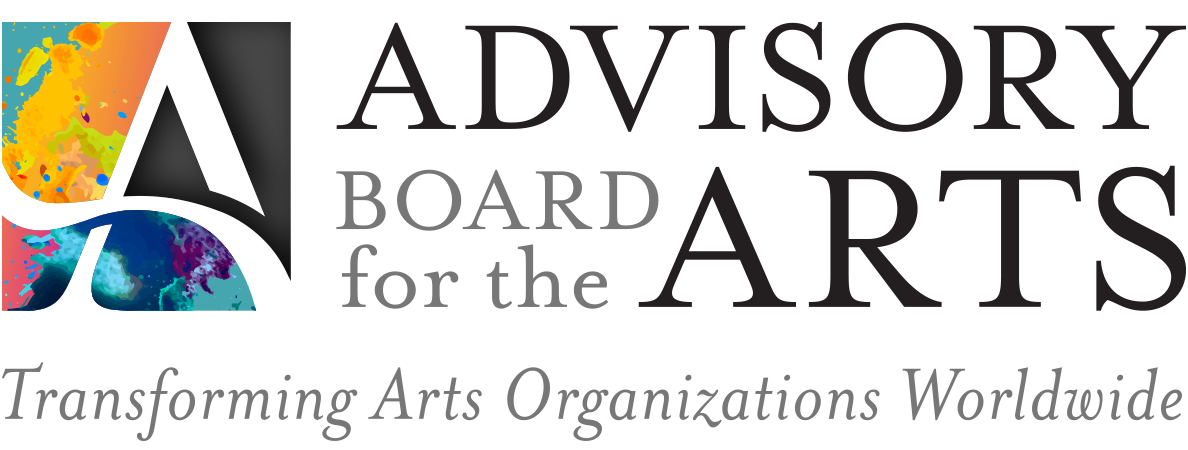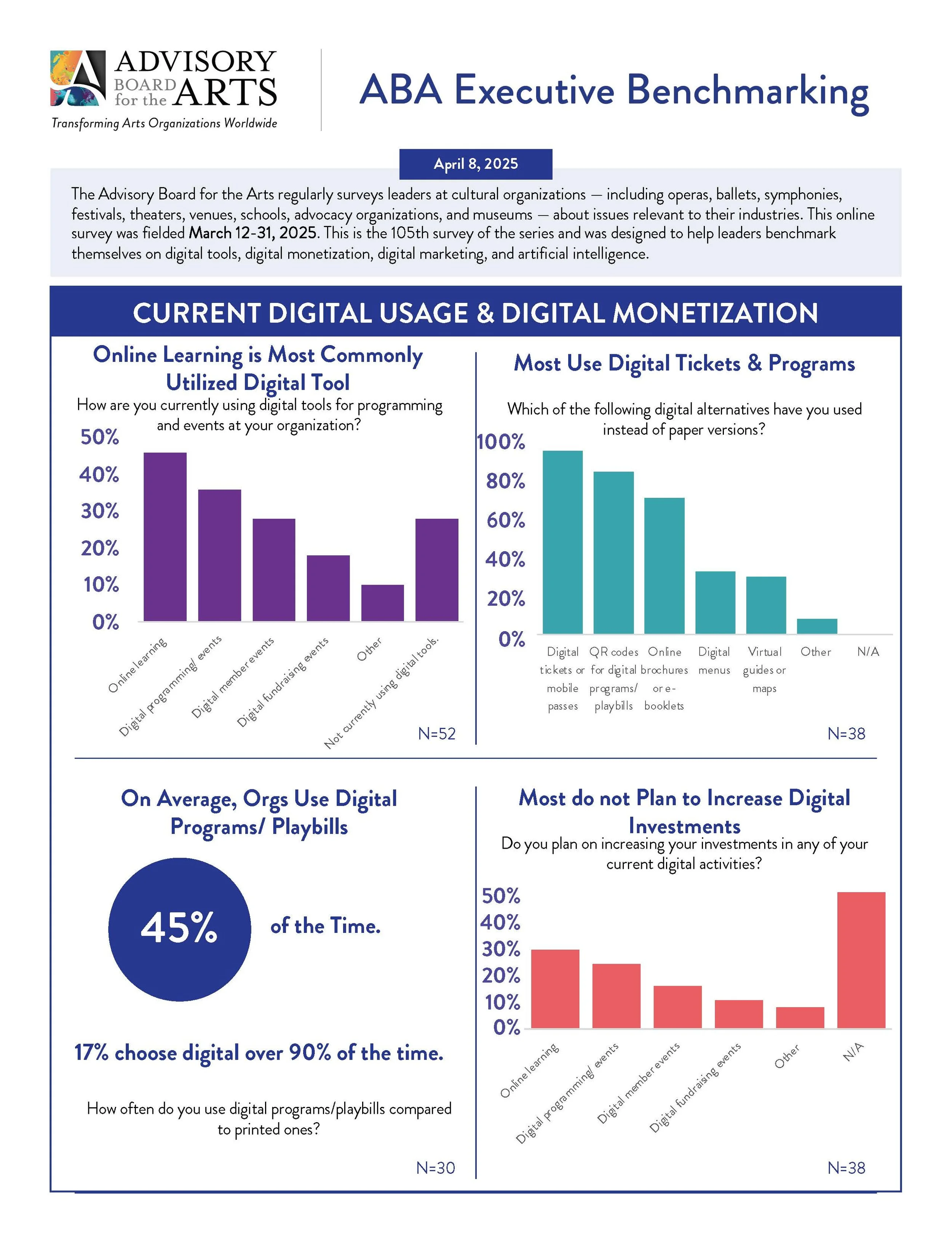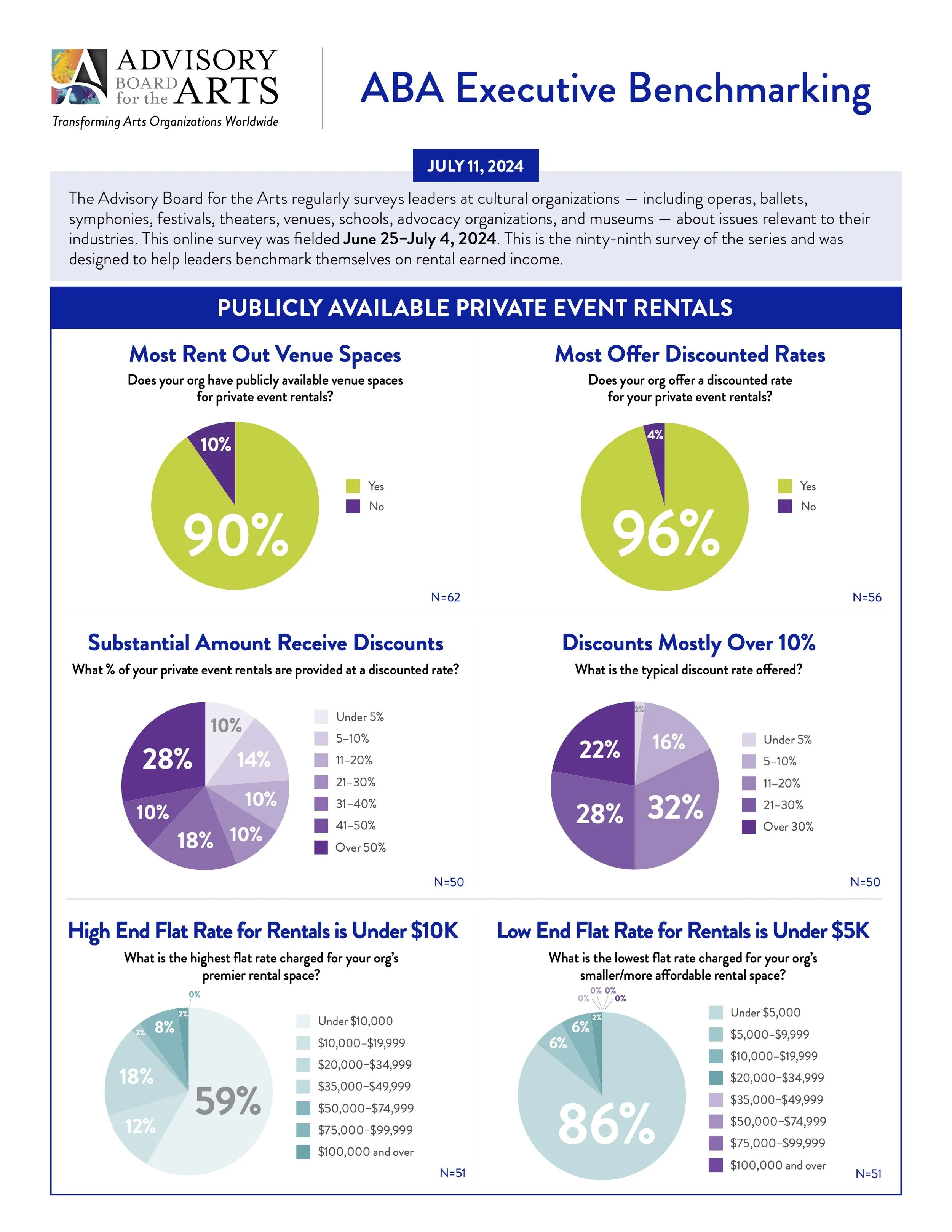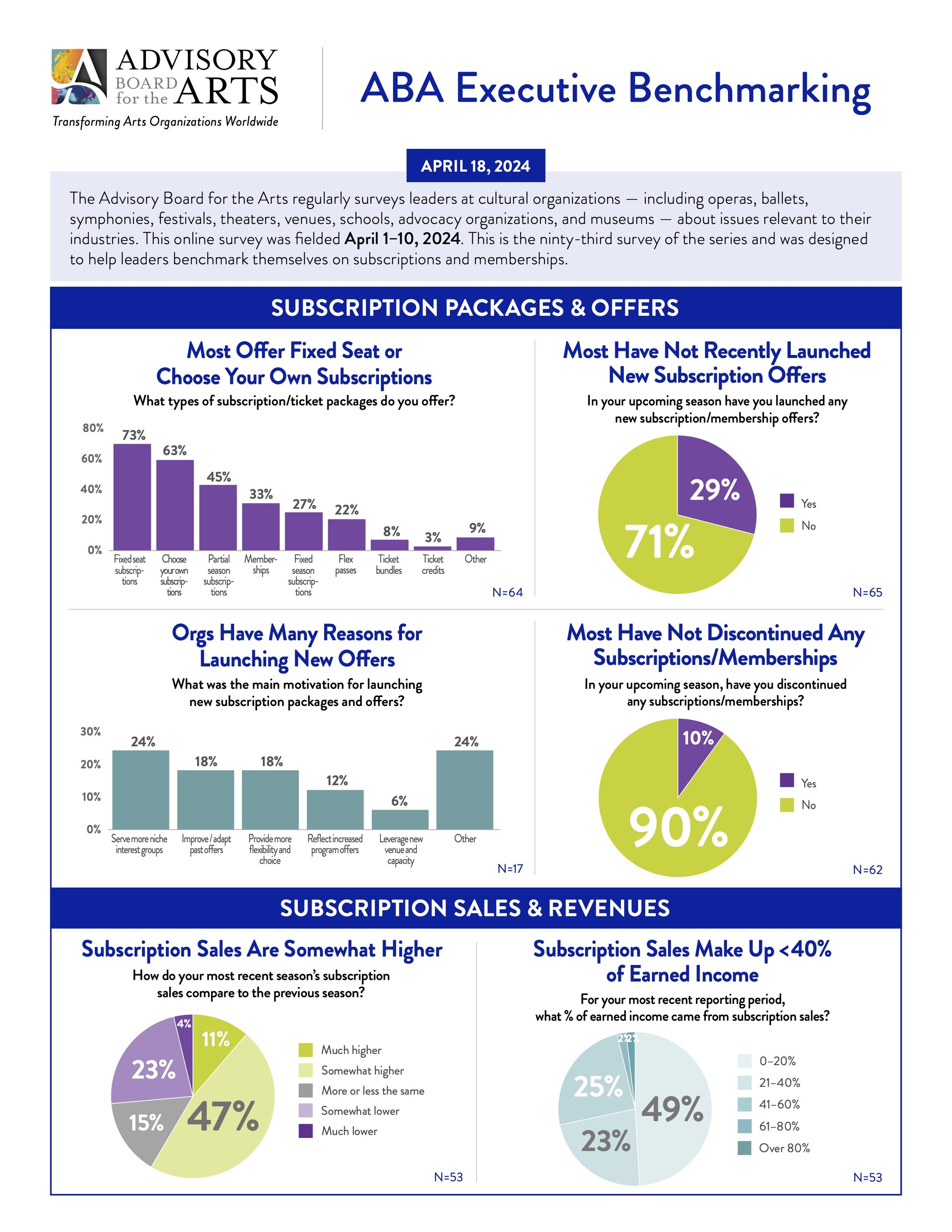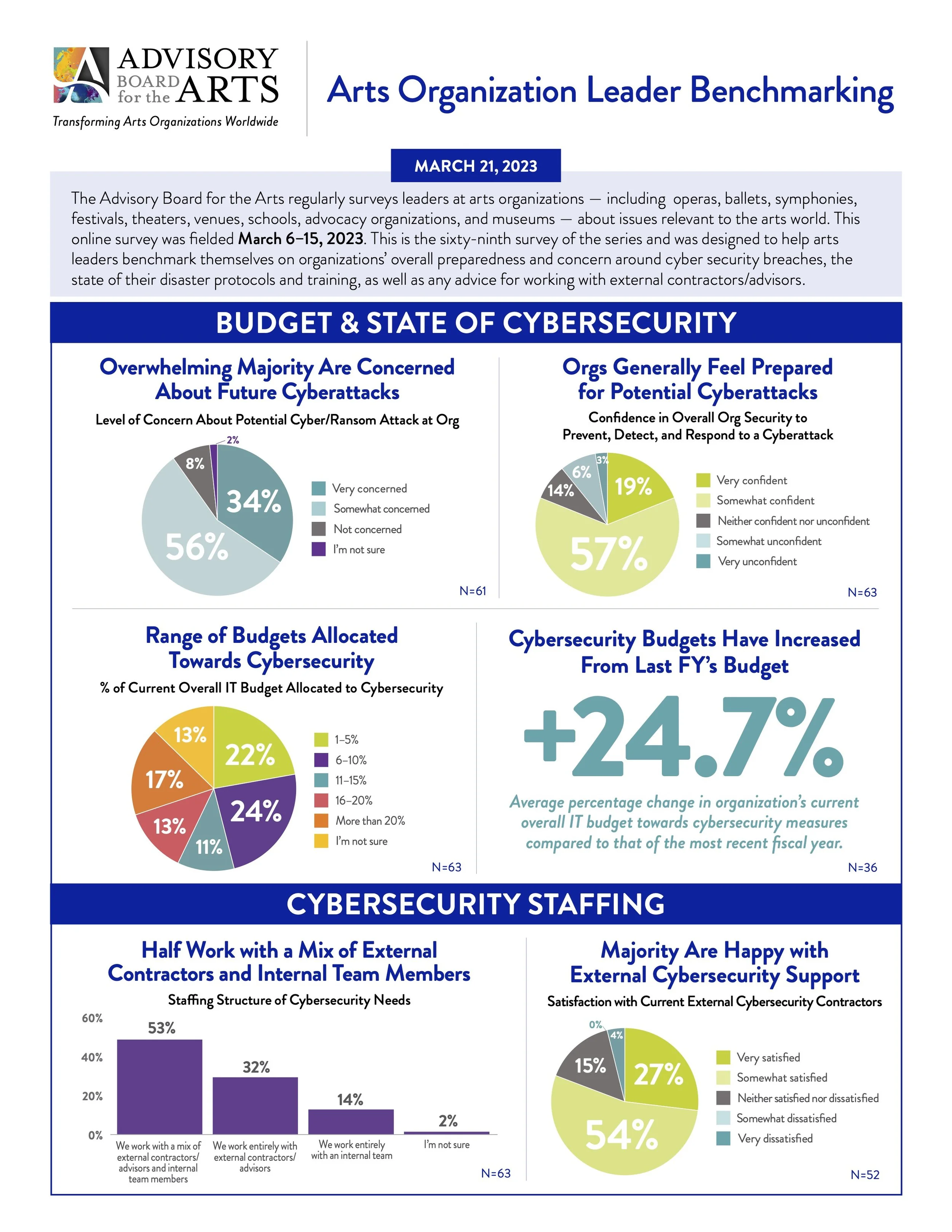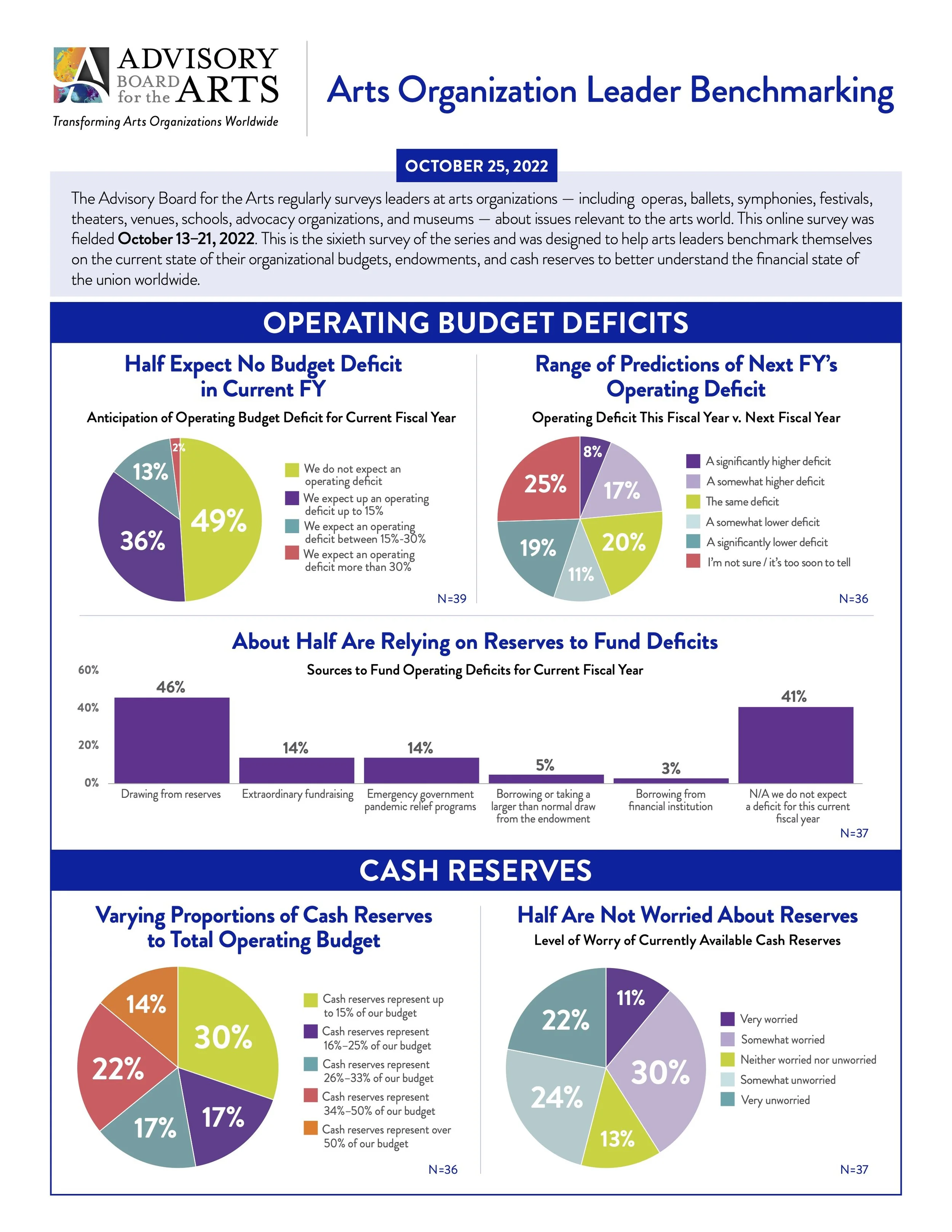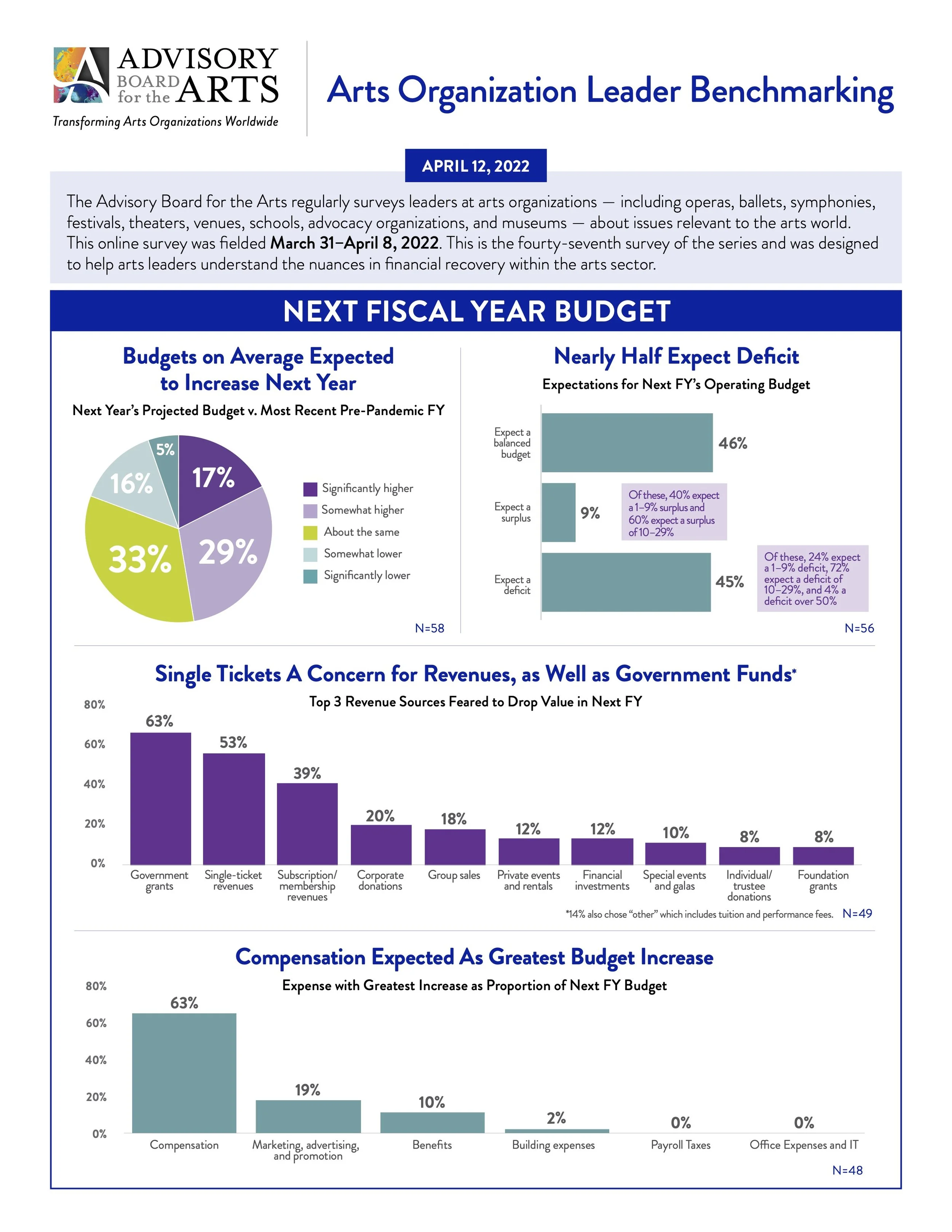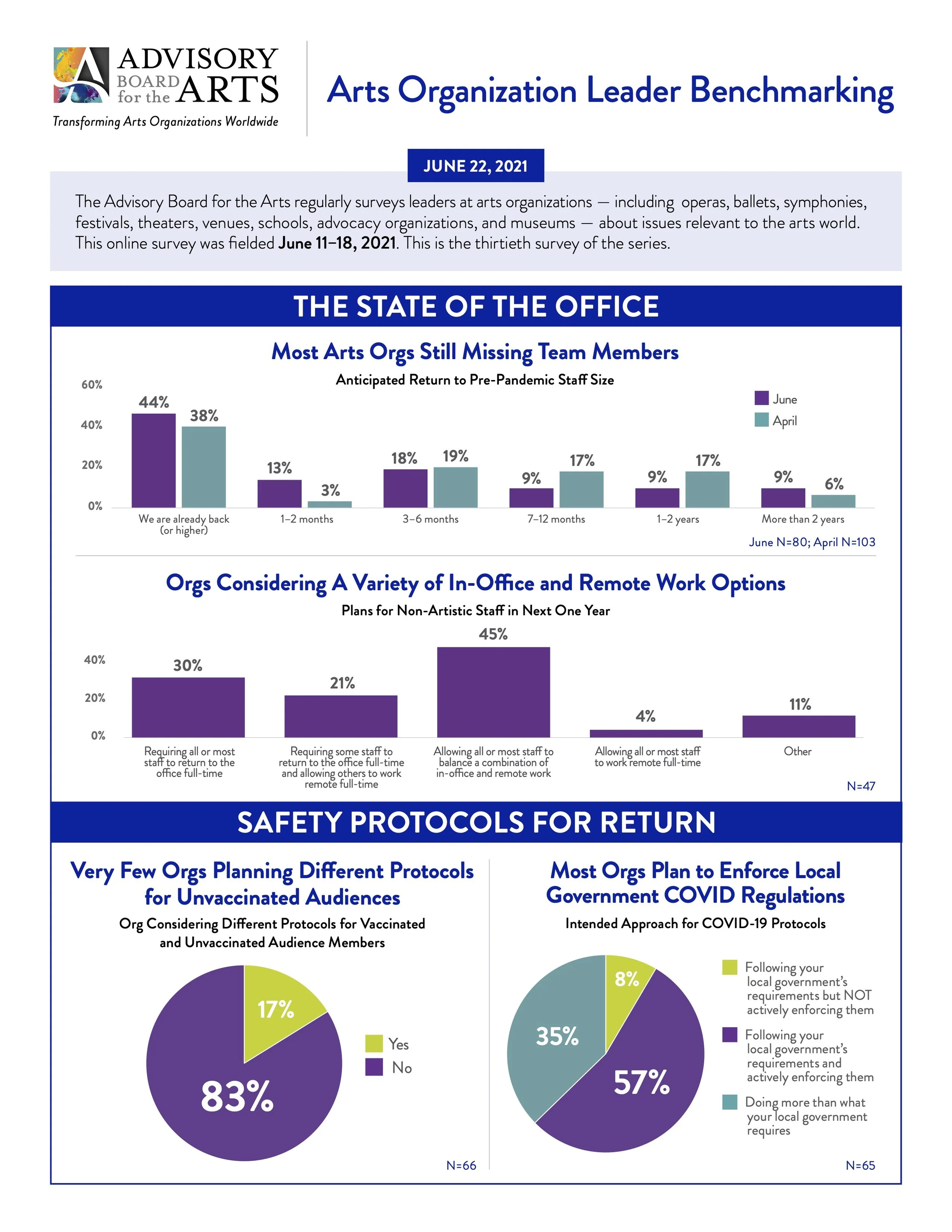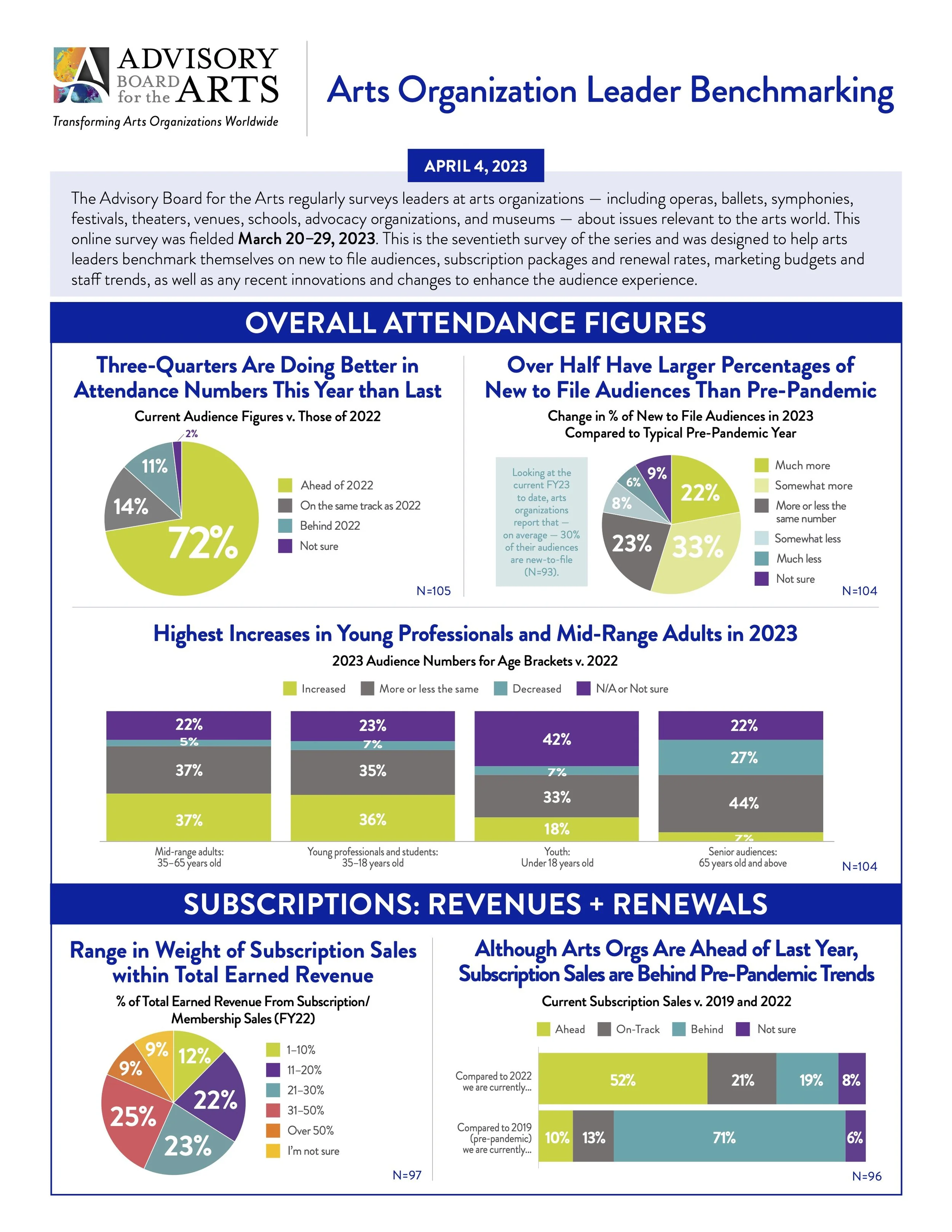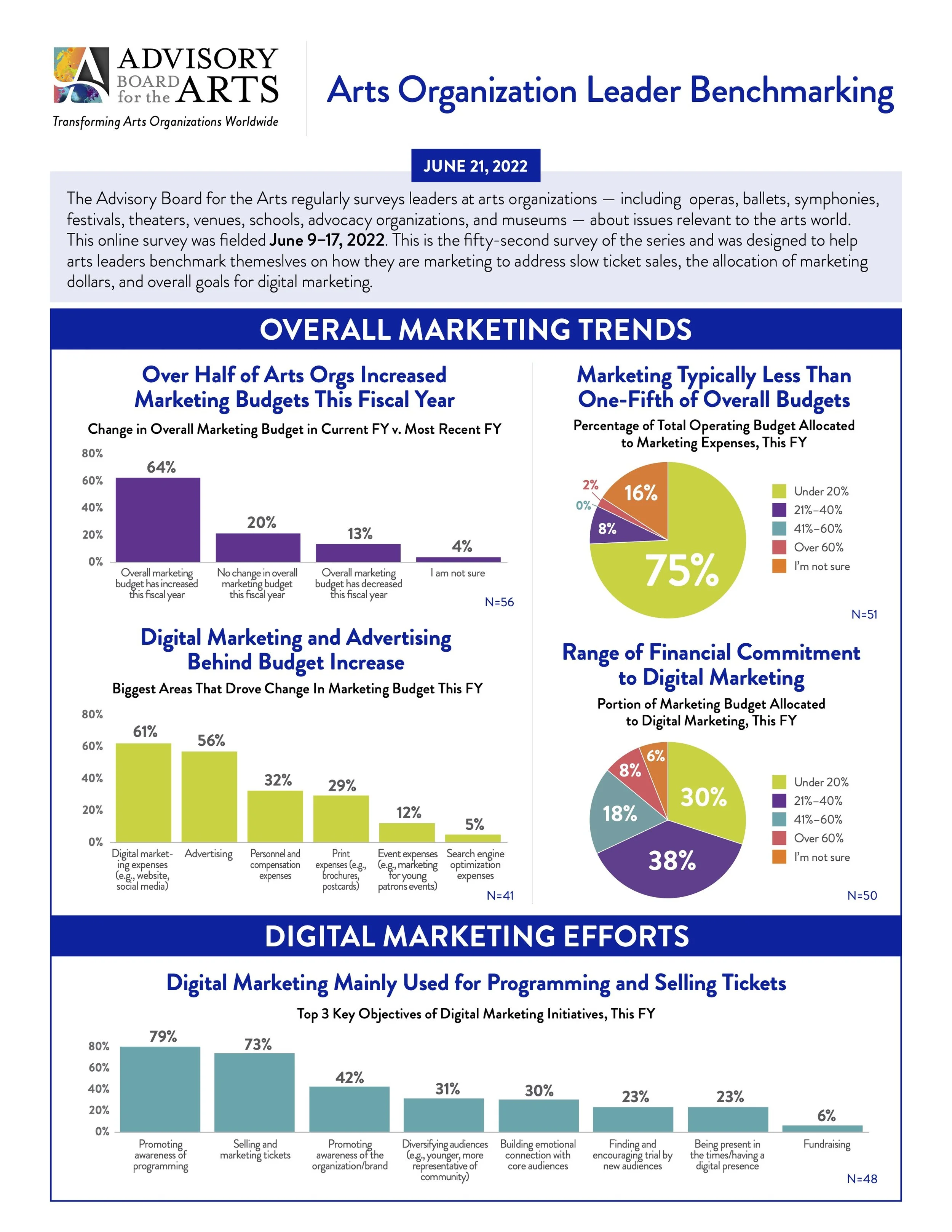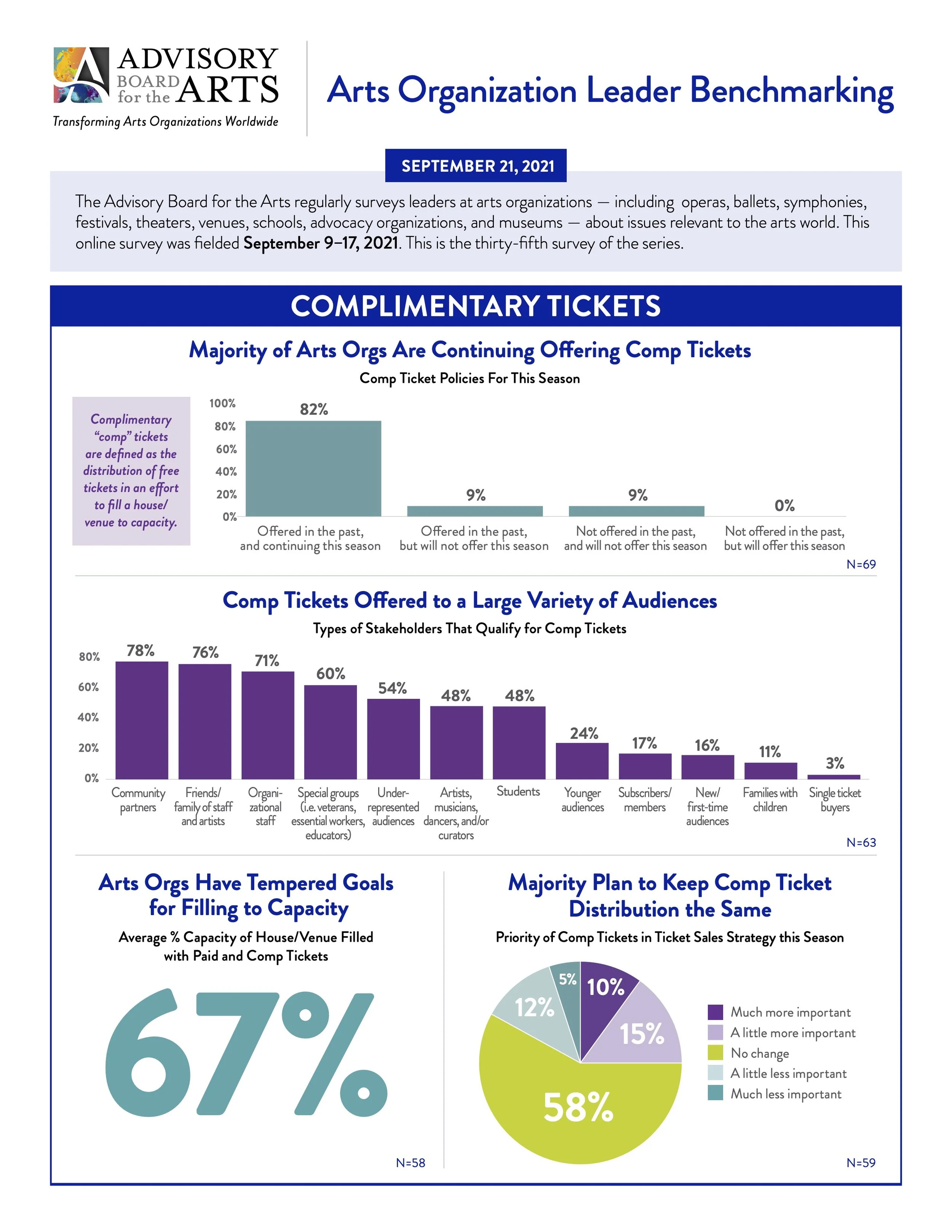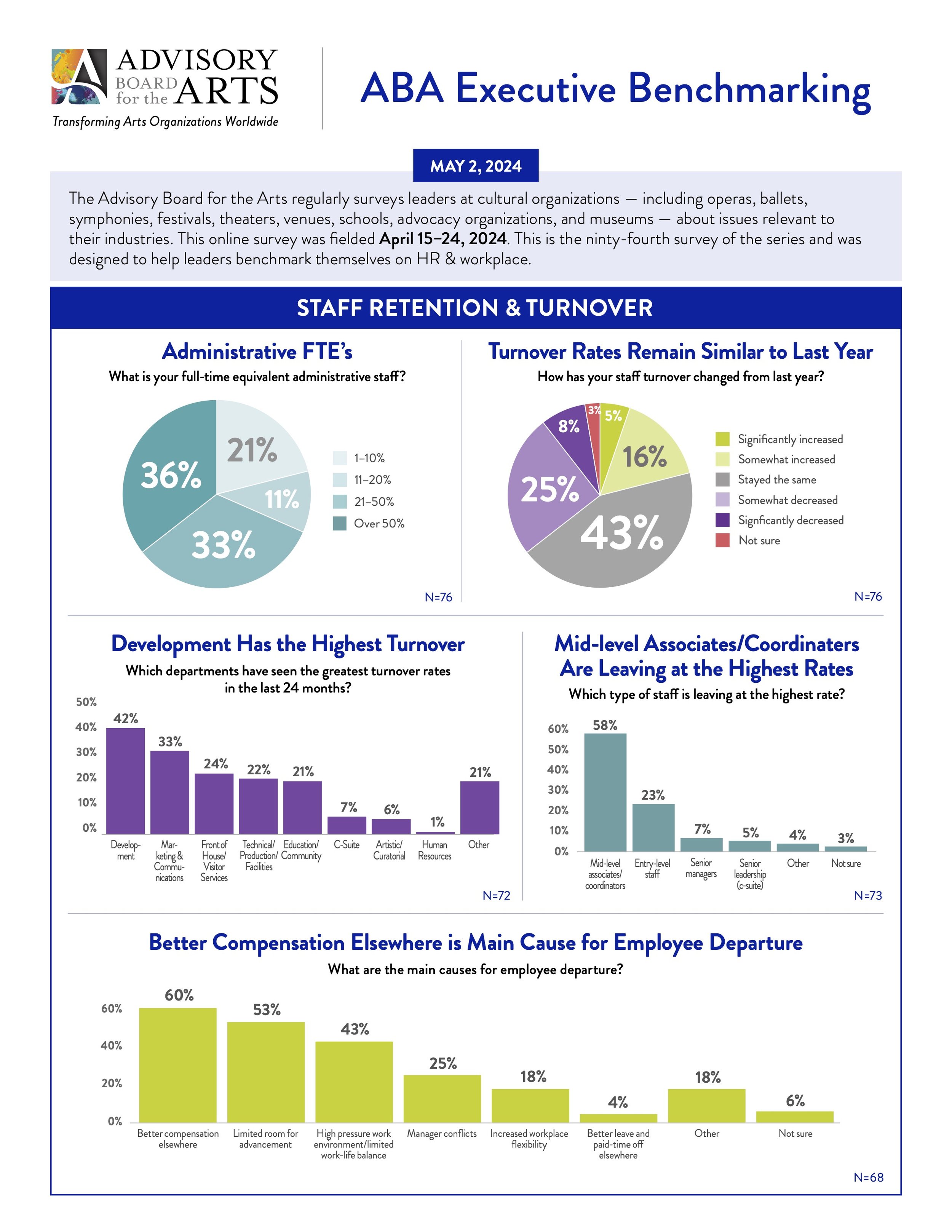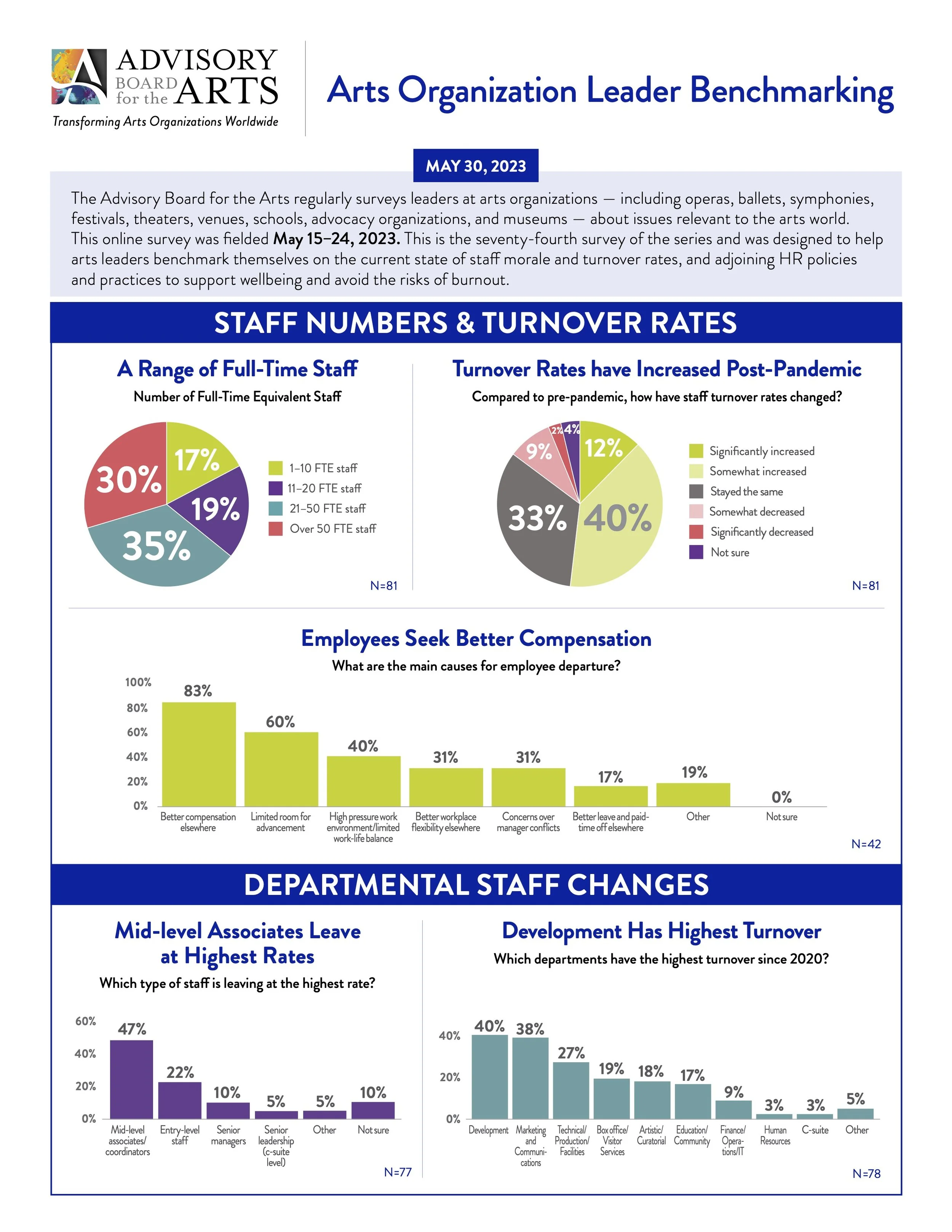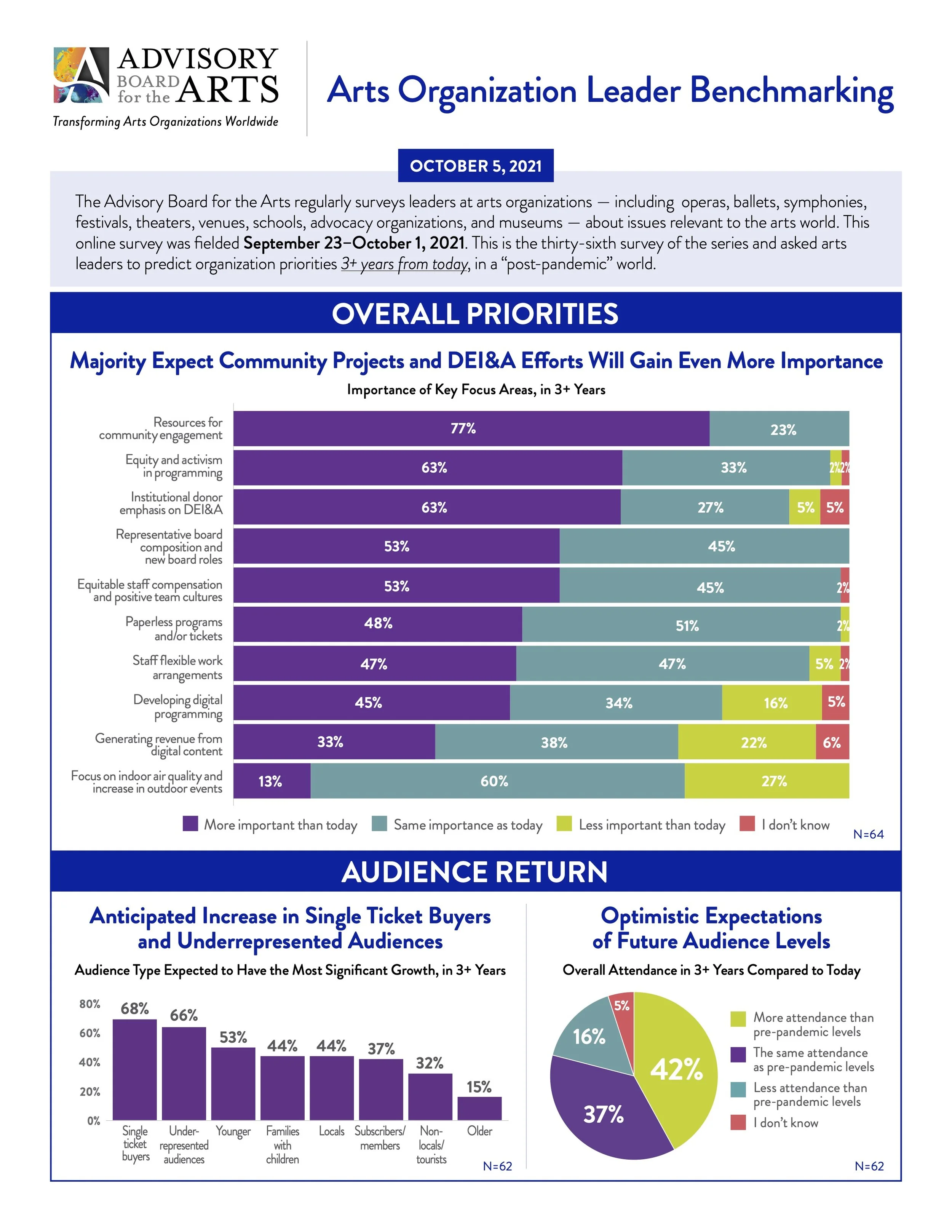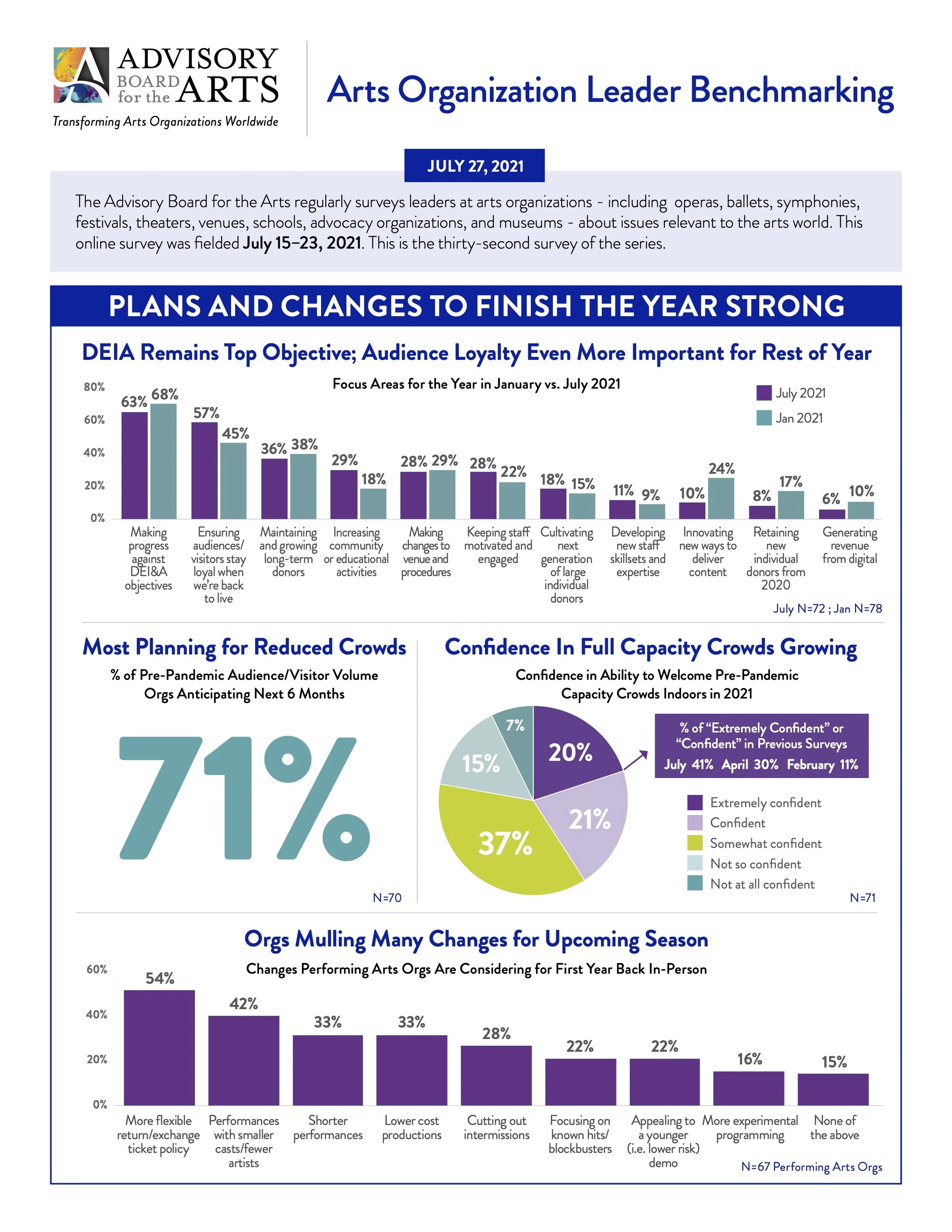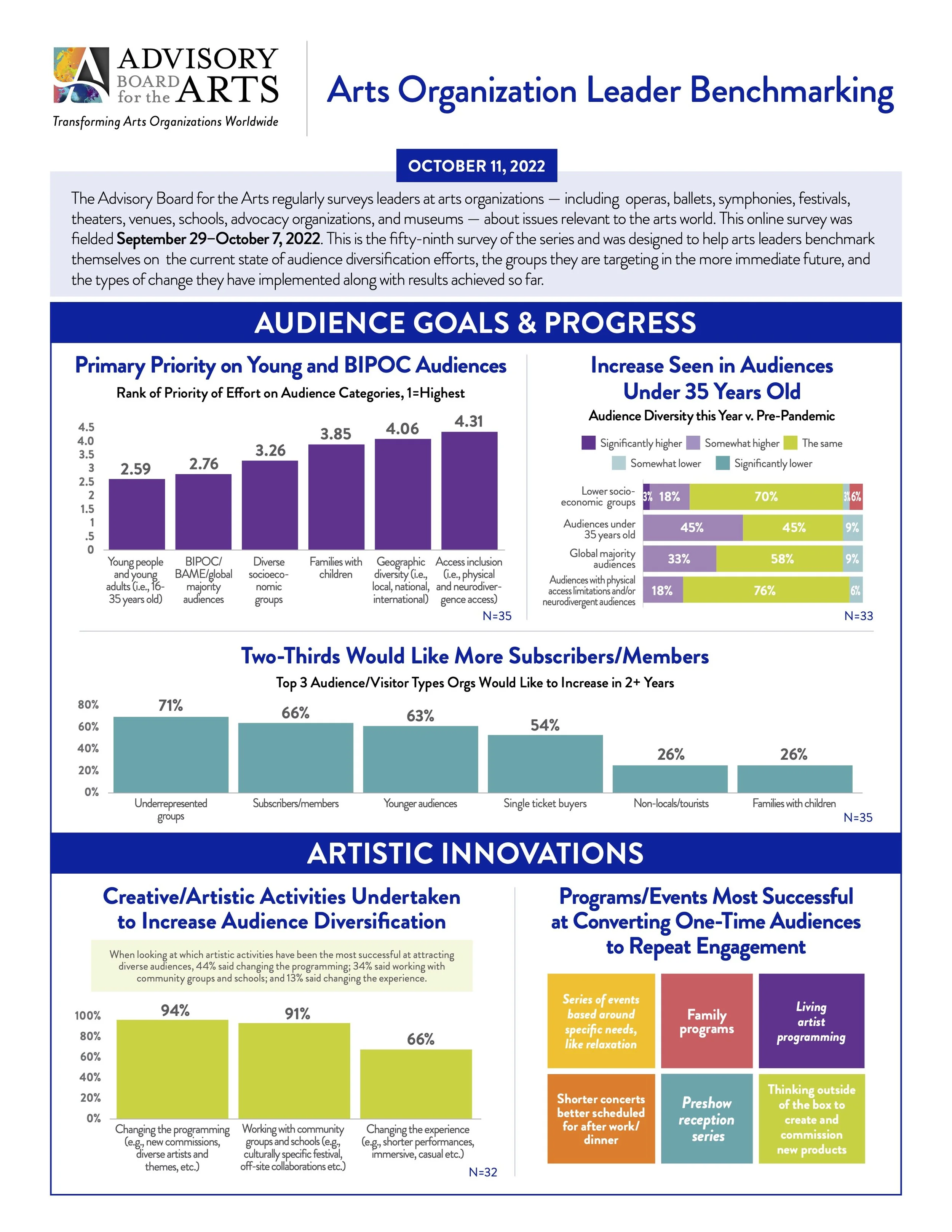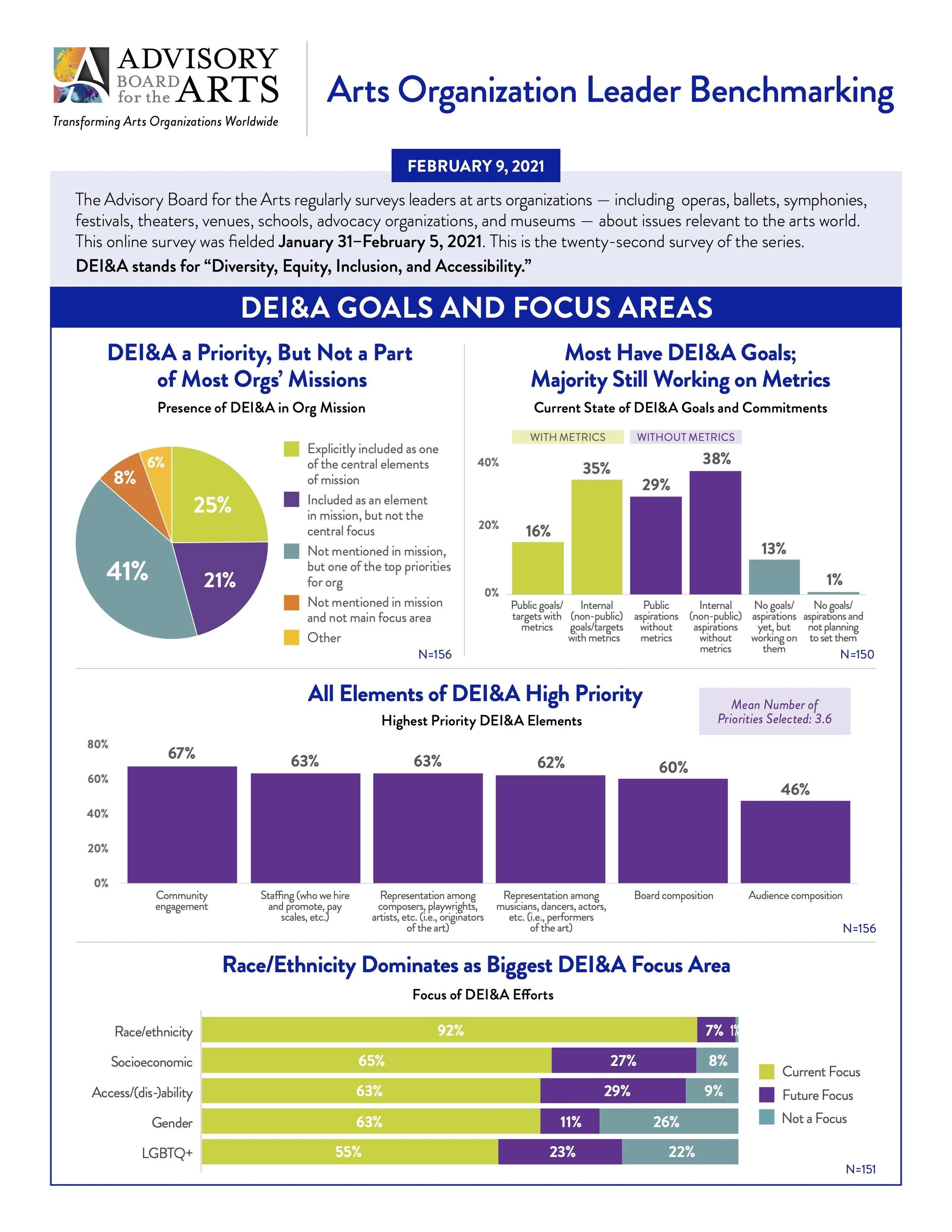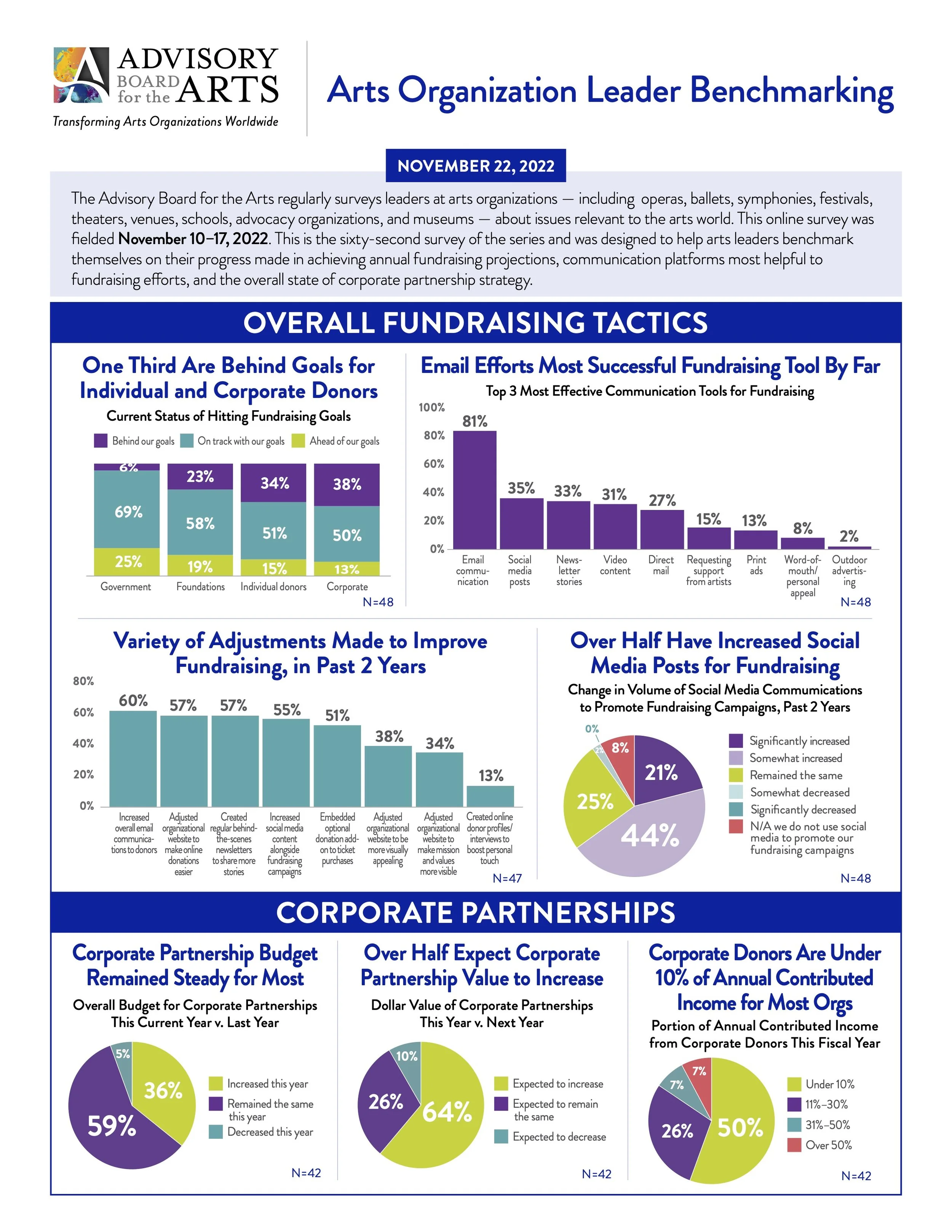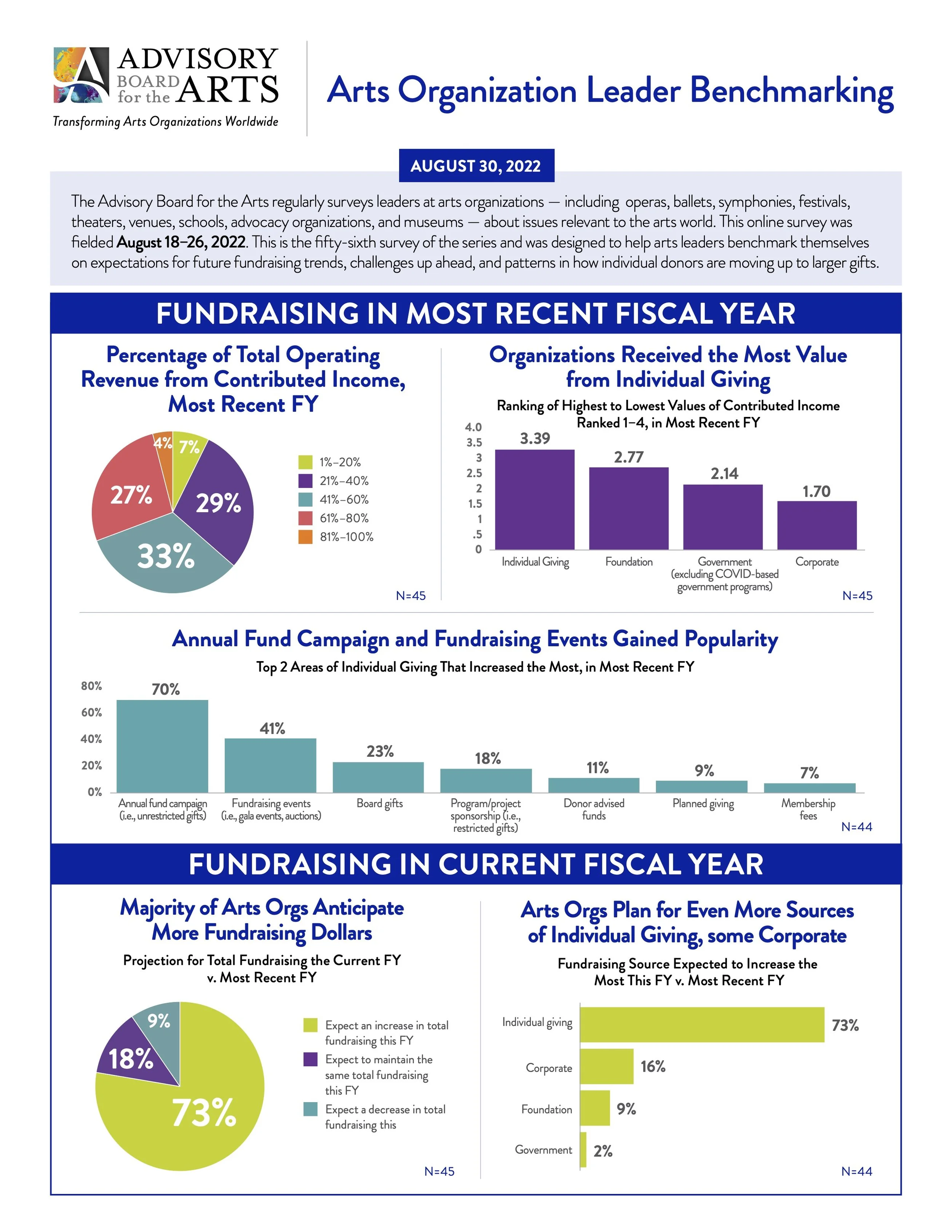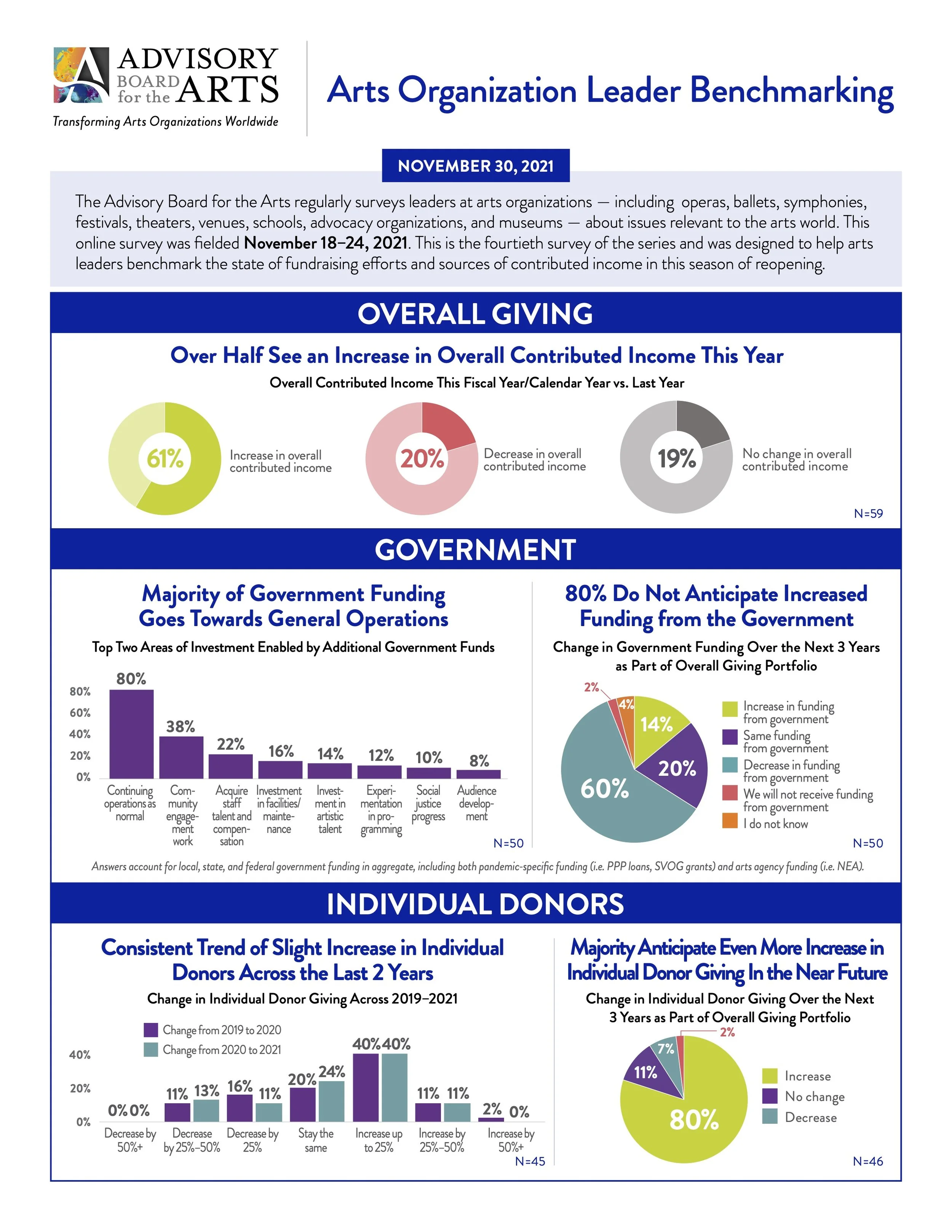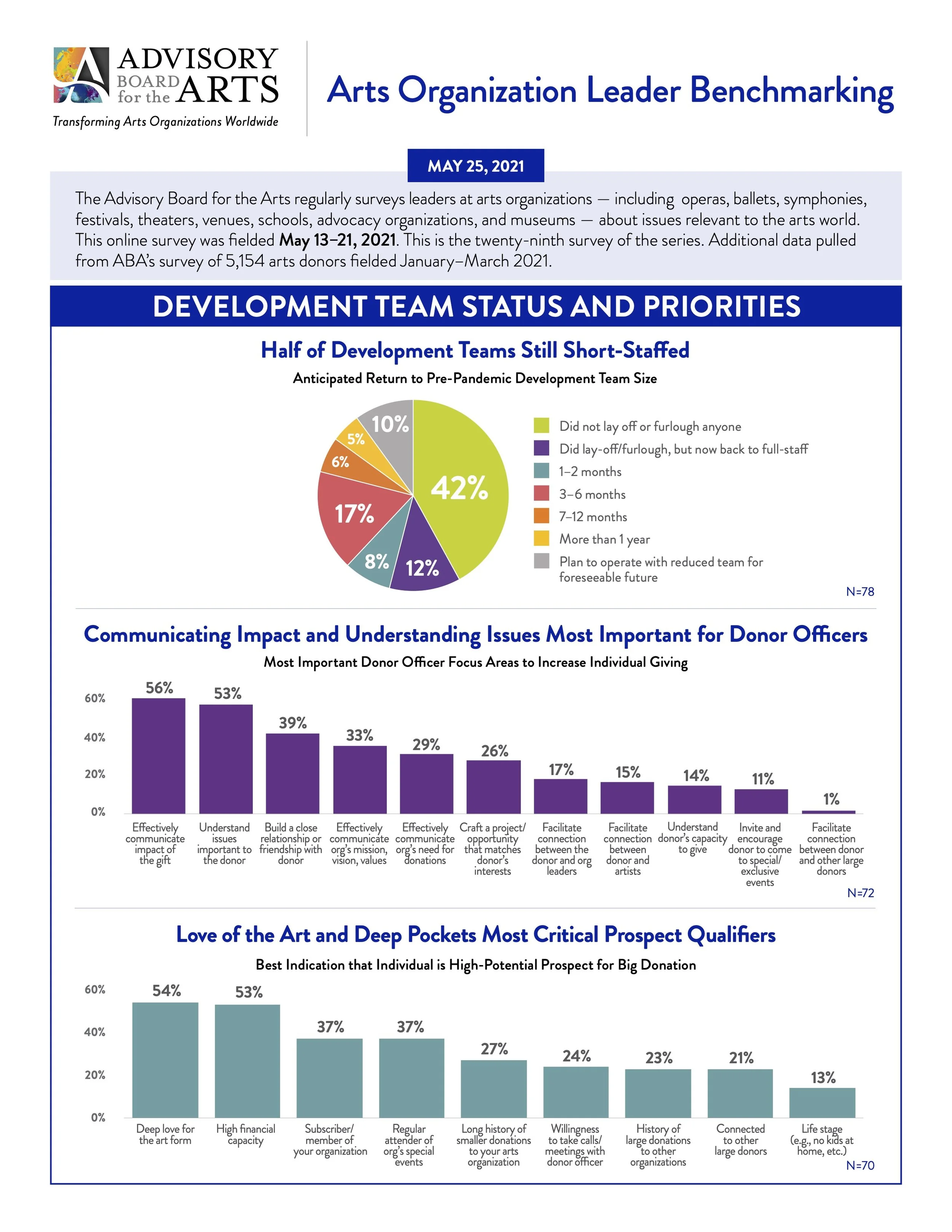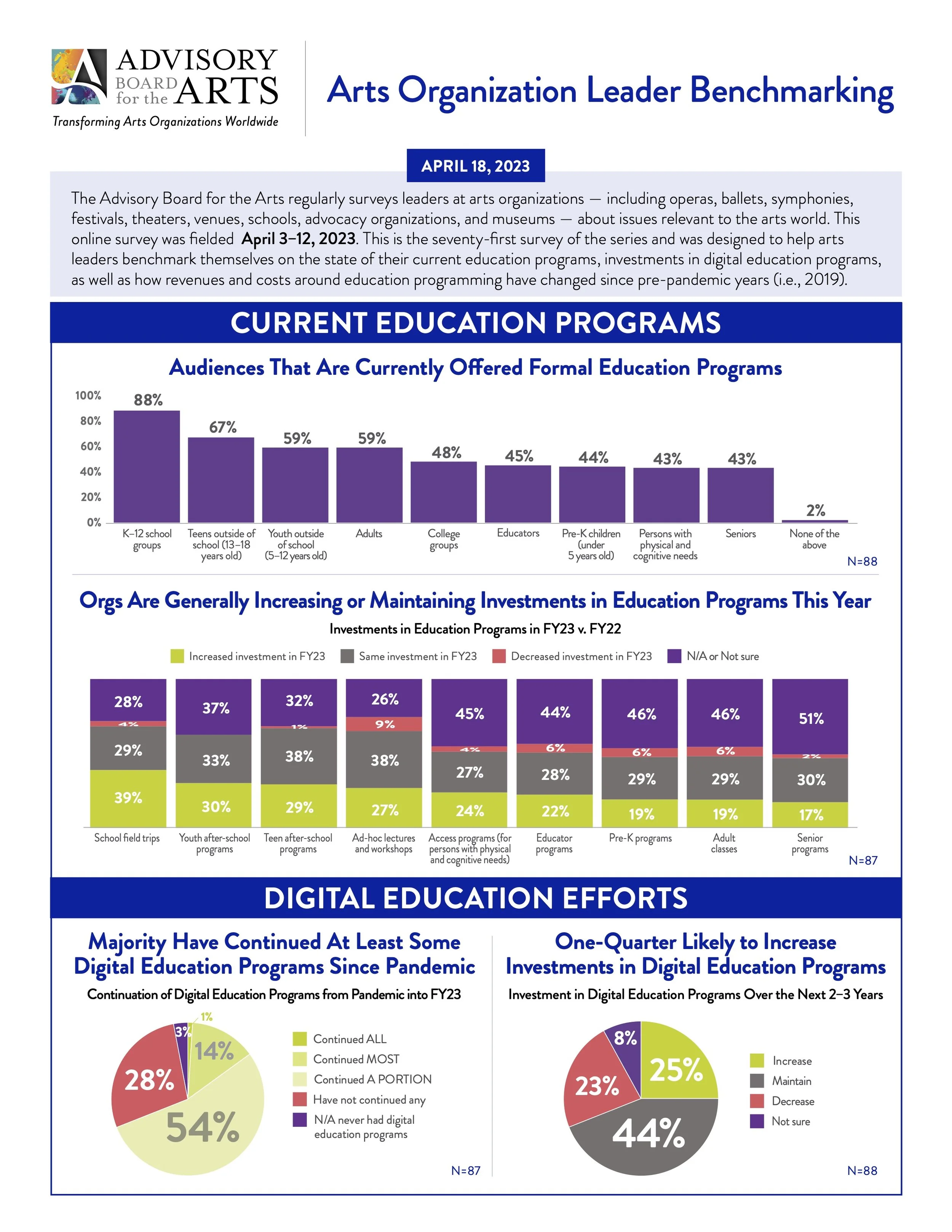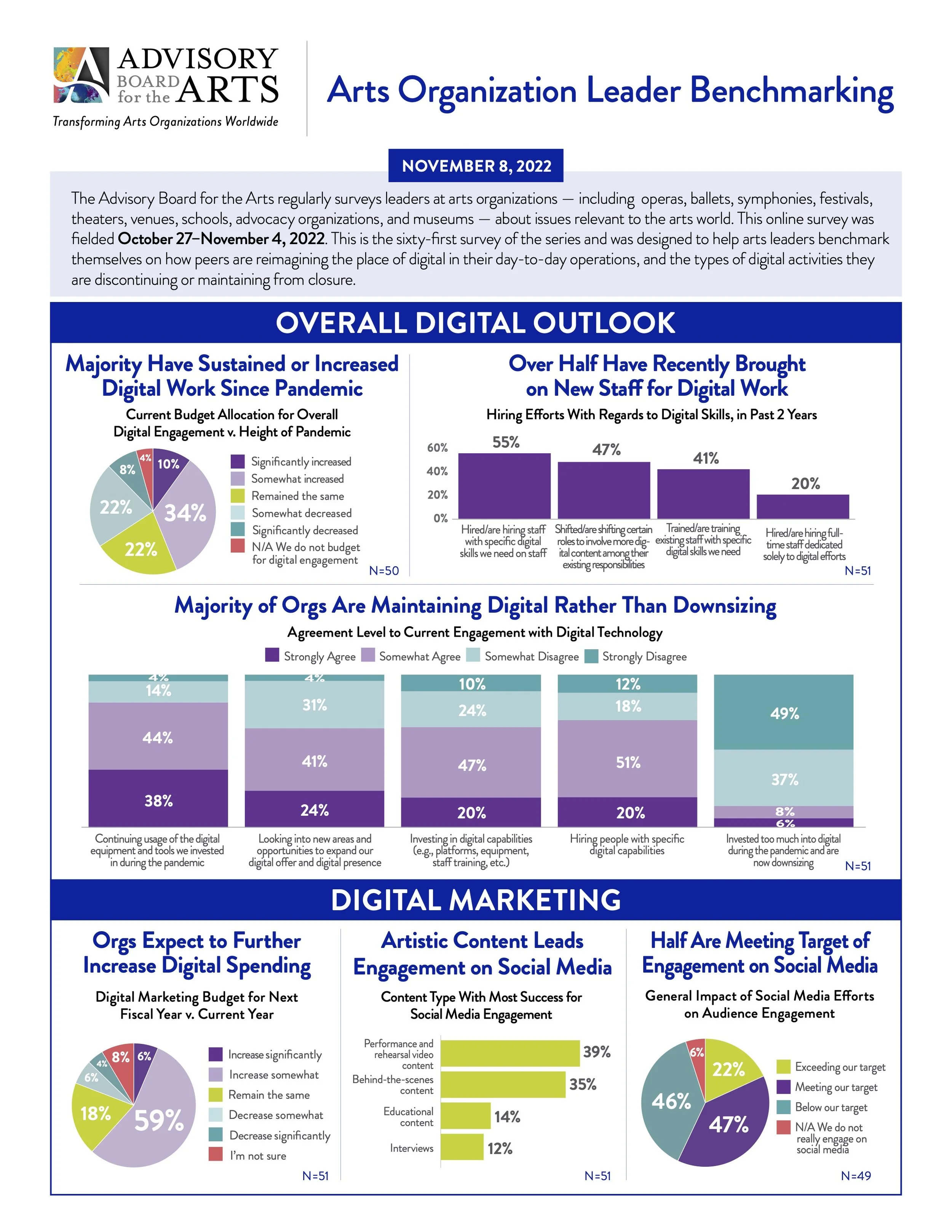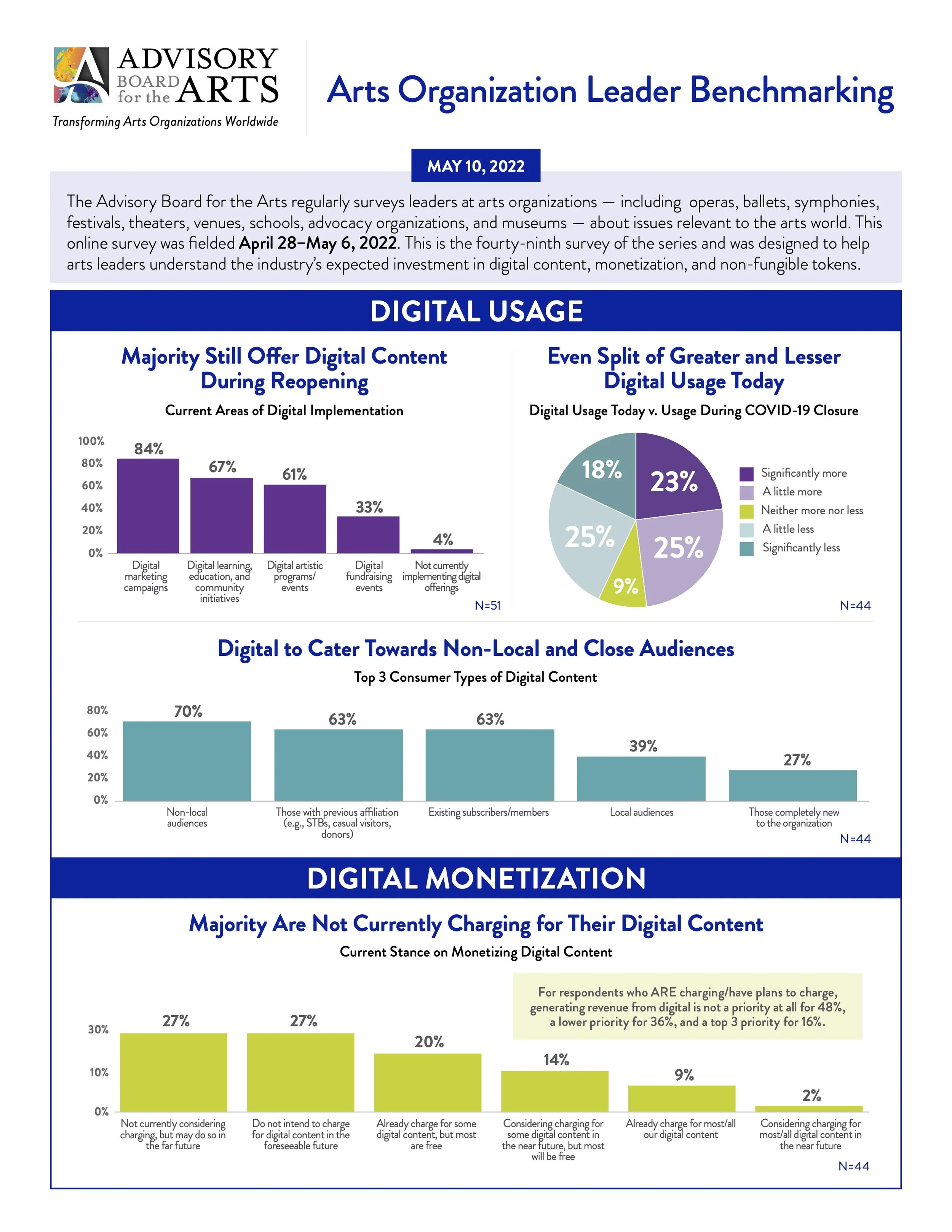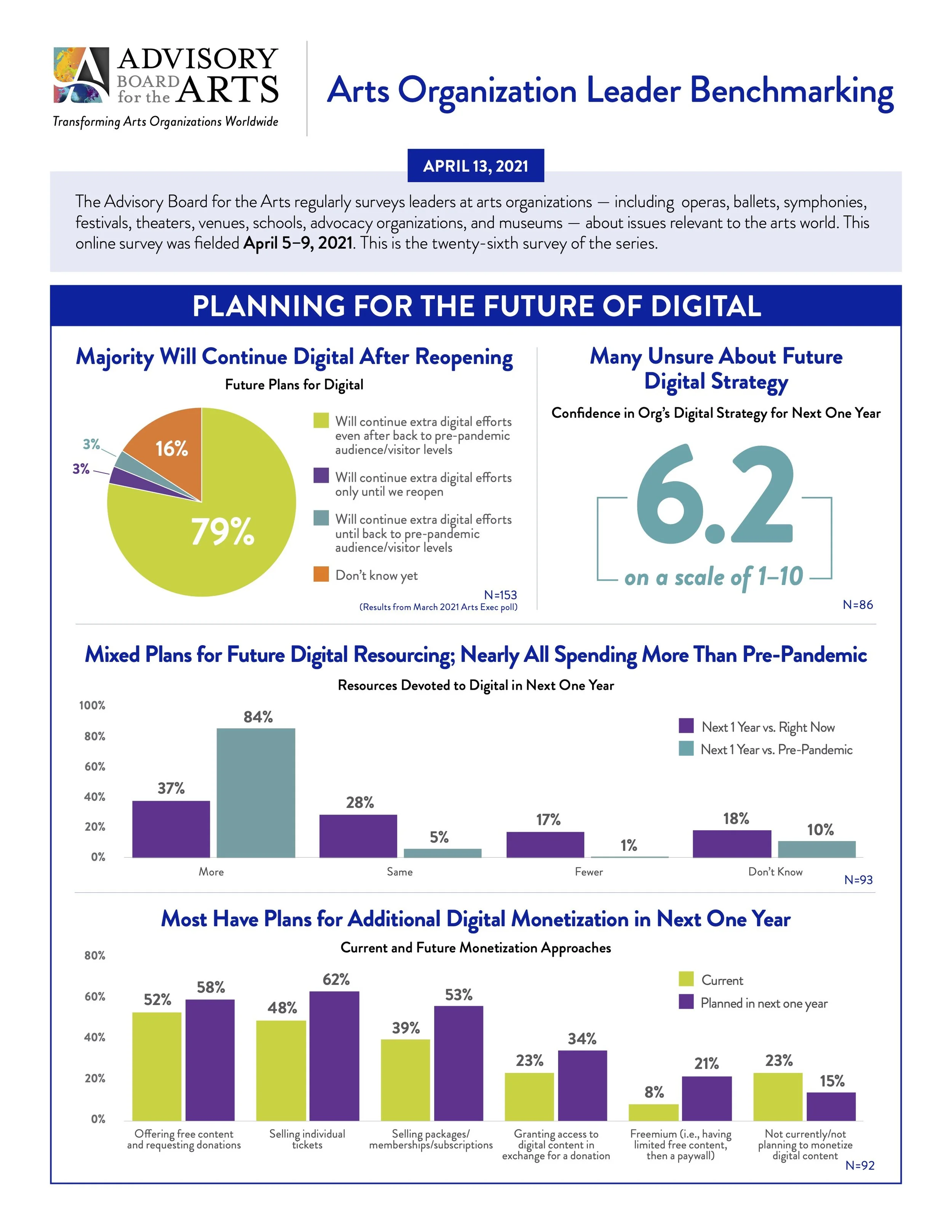The Advisory Board for the Arts offers biweekly arts and culture executive benchmark surveys on priority focus areas that are top-of-mind to leaders. Benchmark yourself against your peers by participating in surveys and gaining insights from the results. All data is published in our ABA Spotlight newsletter. All benchmarks are presented in reverse chronological order and grouped by topic.
Library
Jump to Topics
Arts Resilience | Audience | Arts Management | DEI&A | Donor and Government | Education & Community | Digital Arts and Culture

Search tip: Search for keywords on this page using your browser search or find function.
Arts Resilience
Our latest ABA Executive Benchmark explored the Digital and AI usage in the arts and cultural sectors.
Our latest ABA Executive Benchmark explored the financial health of organizations, looking back at operating costs and budgets for 2024 compared to the previous year, and projections for 2025.
Our latest ABA Executive Benchmark explored revenues generated from single ticket sales and subscriptions in 2024 with projections for 2025 sales.
Our latest ABA Executive Benchmark explored fundraising revenues generated and expenses HR policies at arts and cultural organizations.
Our latest ABA Executive Benchmark explored rental income at arts and cultural organizations.
Our latest ABA Executive Benchmark explored issues of fraudulent ticket activity and ticket reselling at arts and cultural organizations.
Our latest ABA Executive Benchmark explored the state of capital funds and endowments at arts and cultural organizations.
Our latest ABA Executive Benchmark explored the state of subscriptions and memberships at arts and cultural organizations.
Our latest ABA Executive Benchmark explored holiday season programming and sales at arts and cultural organizations.
Our latest ABA Executive Benchmark explored art and cultural leaders' projections for key financial metrics in 2024.
Our latest ABA Executive Benchmark explored art and cultural organizations’ approaches to artistic and exhibition planning.
Our latest ABA Executive Benchmark explored the state of art and cultural organizations’ institutional fundraising, including government and foundation support.
Our latest ABA Executive Benchmark explored the state of art and cultural organizations’ overall budgets and projections for the new year, as well as the health of endowments, and how organizations report on different funds and reserves.
As we move into the second half of 2023, we wanted to check in on how arts institutions are faring, the overall state and sentiment about the last 6 months, how organizations are preparing for the remainder of the year, and the overall outlook for the sector. Our latest ABA Executive Benchmark asked arts and culture leaders to share the current state of their organizations’ ticket/membership sale health, operating budgets, and financial forecasts.
As many arts and cultural organizations start to review their budgets for the next fiscal year with their boards, it is crucial to take stock of how the overall state of expenses and revenues for this fiscal year compare to that of the last pre-pandemic season (i.e., 2019). Our latest Arts Leader Survey asked arts leaders to benchmark themselves about organizations’ projections for the upcoming year as well as any anticipated changes to their business models.
In recent months, arts organizations have experienced major cyber security breaches, putting the industry on high alert for reevaluating security protocols. Our latest Arts Leader Survey asked arts leaders to benchmark themselves on their overall preparedness and concern around cyber security breaches, the state of their disaster protocols and training, as well as any advice for working with external contractors/advisors.
For ABA’s last arts executive poll of 2022, we wanted to thank our Spotlight subscribers for celebrating another year with us. We wrapped up this year with a fun survey to learn about everyone's best moments of the year and how everyone plans to celebrate the holiday season.
Our latest Arts Leader Survey asked arts leaders to benchmark themselves on their most positive activities of the year, best moments to look back on, favorite shows/exhibitions, and holiday traditions.
With the looming threat of a recession and rising inflation rates around the world, discussion around securing capitalization has increased amongst arts organizations who are keen to stabilize their financial sustainability. Our latest Arts Leader Survey asked arts leaders to benchmark themselves on the current state of their organizational budgets, endowments, and cash reserves so we can better understand the financial state of the union worldwide.
In the wake of the recent Ransomware attack on the digital marketing tool WordFly, decisions around technology have never been more important for the secure running of arts and cultural organizations. Our latest Arts Leader Survey asked arts leaders to benchmark themselves on the different platforms they use across different activities, recent changes in vendors, and the features they are most satisfied with when evaluating CRM platforms.
In the wake of the recent Ransomware attack on the digital marketing tool WordFly, decisions around technology have never been more important for the secure running of arts and cultural organizations. Our latest Arts Leader Survey asked arts leaders to benchmark themselves on the different platforms they use across different activities, recent changes in vendors, and the features they are most satisfied with when evaluating CRM platforms.
As indoor mask mandates and vaccine requirements continue to be lifted across the globe as governments prepare for the next phase of living with COVID-19 arts organizations are wondering how these changes will impact in-person visitor and staff returns. Our latest Arts Executive Poll asked arts leaders to benchmark themselves on COVID-19 policies for administrative staff, audiences/visitors, and artists, as well as other implemented safety measures.
Over the past decade, action on environmental sustainability has gained significant traction within both the public and private sectors, including the arts. Our latest Arts Executive Poll asked arts leaders on how their organizations are thinking about and making progress in this area.
Over the past decade, action on environmental sustainability has gained significant traction within both the public and private sectors, including the arts. Our latest Arts Executive Poll asked arts leaders on how their organizations are thinking about and making progress in this area.
As arts organizations plan to bring people back into their offices and their halls, they must carefully balance the needs and demands of multiple stakeholder groups. Our recent Arts Executive poll surveyed leaders on their plans to keep staff, artists, and audiences safe as they reopen.
As vaccine roll-outs continue across the world, arts organizations are starting to move more actively into "return-mode." But with the promise of large in-person gatherings comes the challenges of planning for both safety and org success. Our recent Arts Executive Poll surveyed leaders on a variety of topics related to bringing staff, artists, and audiences/visitors back.
Audience
Our latest ABA Executive Benchmark explored revenues generated from single ticket sales and subscriptions in 2024 with projections for 2025 sales.
Our latest ABA Executive Benchmark explored the state of subscriptions and memberships at arts and cultural organizations.
Our latest ABA Executive Benchmark explored holiday season programming and sales at arts and cultural organizations.
Our latest ABA Executive Benchmark asked arts and cultural leaders about the state of their most recent season or year-to-date sales, including single tickets, subscription and memberships, and group sales.
As many organizations finalize their upcoming fiscal year budgets, we wanted to learn about how organizations are planning their marketing budgets - looking across overall budgetary spends, and specific areas of investment such as digital marketing efforts. Our latest ABA Executive Benchmark asked arts leaders about marketing budgets and changes due to the increased importance of digital.
Since reopening from the closures of the pandemic, arts and cultural organizations have stayed vigilant in assessing the state of their recovery and sales. Our latest Arts Leader Survey asked arts leaders to benchmark themselves about the current state of single ticket sales, filled hall capacities, subscriptions, and no-show rates across the performing arts sector today compared to 2019 (pre-pandemic).
As we enter spring months, arts organizations want to take stock of how their marketing efforts and subscriptions are performing this year. Our latest Arts Leader Survey asked arts leaders to benchmark themselves on new to file audiences, subscription packages and renewal rates, marketing budgets and staff trends, as well as any recent innovations and changes to enhance the audience experience.
As we finalize plans for a new year of arts and programming, many organizations are reviewing their ticket promotions and packages to see what opportunities there may be in engaging returning and new target audiences. Our latest Arts Leader Survey asked arts leaders to benchmark themselves on the kinds of tickets schemes and discounts they currently have, as well as those which are under consideration or even discontinuing. We are also interested in particular efforts to engage with young adults across the sector.
As we return after the New Year, we want to take a quick moment to look back on the previous season in order to set a baseline for overall organizational performance and ticket sales, as well as the industry’s strategic outlook for the coming year. Our latest Arts Leader Survey asked arts leaders to benchmark themselves on the past year's attendance, ticket and subscription sales, and how performance on these factors has impacted future strategies. We also wanted to learn about priorities, and the greatest concerns and opportunities in the months to come.
With articles from Artnet (July 2022) and The New York Times (August 2022) revealing a continued decline in attendance relative to pre-pandemic levels at US arts and cultural institutions, we want to learn about the state of attendance and subscriptions worldwide. Our latest Arts Leader Survey asked arts leaders to benchmark themselves on overall attendance rates, single ticket and membership/subscription sales, direct mail campaign, and ongoing COVID-19 protocols that may be impacting returning audiences.
As many arts organizations wrap up their most recent season and look towards their next fiscal budget, questions and challenges remain over ticket sales and the return of audiences and visitors. Our latest Arts Leader Survey asked arts leaders to benchmark themselves on how the arts world is addressing slower ticket sales, the allocation of marketing dollars, and overall goals for digital marketing.
As arts organizations open their doors and reopen to the public in this new season, ticket sales are top of mind for audience return. To understand how teams are innovating on this front, our recent Arts Executive Poll surveyed leaders at arts organizations about how they are implementing affordable ticket initiatives to remain accessible to a broad audience and offering complimentary tickets to help fill out houses and venues.
Many arts organizations are looking to get back to some semblance of "normal" in the second half of 2021 and are making preparations to welcome audiences and visitors back at or near pre-pandemic capacity. Our recent Arts Executive poll surveyed leaders about their goals, predictions, and worries for the rest of the year.
Arts Management
Our latest ABA Executive Benchmark explored HR policies, trends and practices at arts and cultural organizations.
Our latest ABA Executive Benchmark explored board governance structures and procedures at arts and cultural organizations.
Our latest ABA Executive Benchmark explored HR policies and workplace morale at arts and cultural organizations.
Our latest ABA Executive Benchmark explored internal communications practices at arts and cultural organizations.
Our latest ABA Executive Benchmark explored art and cultural leaders' projections for key financial metrics in 2024.
Our latest ABA Executive Benchmark explored art and cultural organizations’ approaches to artistic and exhibition planning.
Our latest ABA Executive Benchmark explored the state of art and cultural organizations’ overall budgets and projections for the new year, as well as the health of endowments, and how organizations report on different funds and reserves.
Our latest ABA Executive Benchmark asked arts and cultural leaders about the state of our their current development efforts, including the overall evolution of contributed income in recent years, the budgets allocated to fundraising and donor retention rates.
Our latest ABA Executive Benchmark asked arts and cultural leaders to share the demographic makeup of their organizations, including questions on age, gender, and racial/ethnic background.
As we shift into the second half of the calendar year, we wanted to learn from arts and cultural leaders about the state of their current governing boards, the impact of their board fundraising and any potential plans to change governance practices to further the impact and performance of organizational trustees.
As organizations resume the full scale of their operations with ongoing economic and audience attendance pressures, the state of staff wellbeing and work-life balance has come back to the fore. Our latest Arts Executive Benchmark asked arts leaders to benchmark themselves about the current state staff morale and turnover rates, and adjoining HR policies and practices to support wellbeing and avoid the risks of burnout.
As hybrid work becomes more of a norm, questions about how to manage remote work policies have come to the fore, including which policies work best and what the actual impact is of remote work on staff engagement, retention, and productivity. Our latest Arts Leader Survey asked arts leaders to benchmark themselves on how they are handling their workplace policies, especially around remote work and other flexible models, and what results those policies have yielded.
As the end of the year draws near, we want to understand how arts organizations have fared in terms of their overall staff retention and hiring practices over the last 12 months, as well as perceptions around talent, compensation policies, and workplace culture. Our latest Arts Leader Survey asked arts leaders to benchmark themselves on overall impressions of the hiring landscape, staff composition, shifts in talent qualifications and requirements, and any new processes implemented to improve work environment and pay.
As many arts organizations look to the end of their season and upcoming fiscal year budgets, questions around the structure of governance boards, its various levels of trustees and members, and fundraising objectives have come to the fore. Our latest Arts Leader Survey asked arts leaders to benchmark themselves on their governing board's term durations and reappointments, written procedures and policies, giving requirements, and existing committee types in place.
Arts organizations are increasingly offering flexible work policies to staff, but some jobs are only able to be done in the office. Our latest Arts Executive Poll asked arts leaders to benchmark themselves on how they are implementing digital strategies moving forward and their priorities for digital programming, monetization targets, resources, equity of flex policies, and new technologies.
In the last 18-months arts organizations have faced extreme challenges from the global health crisis to social and racial reckoning. Constituents have demanded change and accountability at all levels of the arts organization, especially in governing boards. Our latest Arts Executive Poll asked arts leaders to benchmark themselves on the state of board policies and structures, recruitment priorities, and other initiatives to diversify governing boards.
With arts organizations navigating the new year and its unique challenges amidst the ongoing pandemic, our latest Arts Executive Poll asked arts leaders about top-of-mind priorities, from setting vaccine requirements in response to COVID-19 variants to benchmarking subscription and ticket sales this season.
As arts organizations safely reopen their doors this fall, arts leaders must leverage this unique moment of return. To help think forward to competing stakeholder demands in a post-pandemic environment, our recent Arts Executive Poll surveyed leaders at arts organizations to understand how they are strategizing for the long-term future.
With the start of September, arts organizations are re-centering themselves and launching new seasons once again. To provide a check-in during these beginning stages, our recent Arts Executive Poll surveyed leaders of arts organizations about the prevailing mood among staff as well as ways that leaders are keeping teams motivated amidst the uncertainty of the pandemic.
As arts organizations open their doors to audiences and visitors, they are simultaneously building back to a full-strength staff. Our recent Arts Executive poll surveyed leaders on the current size of their teams, their hiring plans, and the skills they most want to enhance on their staff.
Diversity, Equity, Inclusion, and Accessibility
Our latest ABA Executive Benchmark asked arts and cultural leaders to share the demographic makeup of their organizations, including questions on age, gender, and racial/ethnic background.
Our latest ABA Executive Benchmark asked arts leaders about specific practices and policies implemented to address and increase representation in the administrative side of organizations, including hiring practices, training and mentorships, flexible working options, and compensation.
As organizations continue to work towards greater inclusion in the arts, we want to learn specifically about the kinds of efforts and investments institutions have made around accessibility for both in-person and digital experiences. Our latest Arts Leader Survey asked arts leaders to benchmark themselves on the current trends in digital and on-site accessibility.
Audience diversification remains a crucial strategic goal for arts organizations as they continue to grapple with questions of attendance, relevance, and long-term sustainability. However, there are a number of tactics arts organizations can implement to try to appeal to broader audiences, and a range of different audience segments one could prioritize. Our latest Arts Leader Survey asked arts leaders to benchmark themselves on the current state of audience diversification efforts, the groups they are targeting in the more immediate future, and the types of change they have implemented along with results achieved so far.
From the pandemic’s disproportionate impact on underrepresented populations to social movements calling for change in organizations across the world, it is critical to understand how arts organizations are engaging in DEI&A policies internally. Our latest Arts Leader Survey asked arts leaders to benchmark themselves on peers on concrete changes made within the workplace.
Issues related to diversity, equity, inclusion, and accessibility (DEI&A) have long been important to arts organizations. The events of 2020 made the need for progress even more intense. We polled arts execs on their goals, focus areas, and challenges surrounding DEI&A.
Donor and Government Engagement
Our latest ABA Executive Benchmark explored development operations at arts and cultural organizations.
Our latest ABA Executive Benchmark explored the state of corporate fundraising at arts and cultural organizations.
Our latest ABA Executive Benchmark explored the state of art and cultural organizations’ institutional fundraising, including government and foundation support.
Our latest ABA Executive Benchmark asked arts and cultural leaders about the state of our their current development efforts, including the overall evolution of contributed income in recent years, the budgets allocated to fundraising and donor retention rates.
As many organizations revisit and/or launch new endowment campaigns, we want to learn about the overall state of major donors and their giving trends, planned giving efforts, and the impacts the pandemic and possible economic slowdown have had on private support.
In recent conversations with members, ABA has heard from many arts and cultural organizations who are rethinking their galas and other benefit events. Our latest Arts Leader Survey asked arts leaders to benchmark themselves on how they are strategizing their galas and donor events for the future, including the budget and return of these events as well as changes in gala structure. We also want to understand the value of galas/benefit events considering the time and fiscal investments surrounding them.
As we near the end of the calendar year, we want to take a moment to look back on past ABA executive leader polls to assess the realities of fundraising projections notably around corporate giving, and learn about new tactics and investments in development overall. Our latest Arts Leader Survey asked arts leaders to benchmark themselves on their current progress made in achieving annual fundraising projections, communication platforms most helpful to fundraising efforts, and the overall state of and changes made to corporate partnership strategy.
After two years of disruptions with the global health crisis and the current impending recession, it is of critical importance to understand the landscape of fundraising efforts. Our latest Arts Leader Survey asked arts leaders to benchmark themselves on expectations for future fundraising trends, giving challenges organizations are preparing for, and patterns in how individual donors are moving up to larger gifts.
With the rise in inflation and the corresponding increases in living and business costs, many cultural institutions are reconsidering how they organize donor and membership programs.
Our latest Arts Executive Poll asked arts leaders how they are prioritizing different fundraising sources into the near future and how their contributed income streams stand today.
Arts organizations have worked hard to stay in the hearts and minds of their donors during the challenges of the past year. Our recent Arts Executive poll surveyed leaders on the state of their development teams, donor reliance on benefits, and the motivations they believe drive donors to give.
Education, Community Engagement, and Learning
Our latest ABA Executive Benchmark explored community engagement at arts and cultural organizations.
Our latest ABA Executive Benchmark explored the management of education programs at arts and cultural organizations.
Many organizations have increased their commitments towards their communities in recent years. We wanted to check in on these efforts, looking across institutional priorities and ongoing program initiatives, as well as staffing and volunteer management practices. Our latest arts leader survey asked arts leaders to benchmark themselves about the current state of community engagement and volunteer management.
As schools and communities across the globe return to more pre-pandemic activities, arts organizations are looking to better serve their communities through education programs. Our latest arts leader survey asked arts leaders to benchmark themselves about the state of their current education programs, investments in digital education programs, as well as how revenues and costs around education programming have changed since pre-pandemic years (i.e., 2019).
With more mask mandates and COVID restrictions being lifted across the globe despite persistent cases, cultural organizations are reevaluating their K-12 education initiatives as they rebuild from programs adjusted during the pandemic. Our latest Arts Leader Survey asked arts leaders to benchmark themselves on changes to the structure of school programs surrounding education budgeting, strategies around student interactions, and operational policies regarding on-site and off-site visits.
Community engagement, equity, and inclusion featured highly among arts leaders’ top priorities according to our 2022 Hot Topics survey, as arts organizations place increasing importance on relevance in their communities. Our latest Arts Executive Poll asked arts leaders to benchmark themselves on how they execute programs that engage diverse constituents in their communities.
Digital Arts and Culture
Our latest ABA Executive Benchmark explored the Digital and AI usage in the arts and cultural sectors.
Our latest ABA Executive Benchmark explored digital & AI usage in arts and cultural organizations.
As most arts and cultural organizations have resumed their full in-person services, the place of digital productions and overall digital investments remains unclear. Are organizations maintaining the capabilities and activities they developed during closure, or are they shifting resources away from those efforts? Our latest Arts Leader Survey asked arts leaders to benchmark themselves on how they are reimagining the place of digital in their day-to-day operations, and the types of digital activities they are discontinuing or maintaining from closure.
Digital strategies, especially related to monetization of digital content, vary significantly across organizations. Our latest Arts Executive Poll asked arts leaders to benchmark themselves on how they are implementing digital strategies moving forward and their priorities for digital programming, monetization targets, resources, and new technologies.
Many arts organizations have made great strides in digital content and experiences during the COVID-19 pandemic. But with the return to in-person experiences (hopefully) drawing nearer, many arts organizations are starting to think about how to evolve their digital strategies for the future. Our recent Arts Executive poll surveyed leaders on their future plans for digital.

